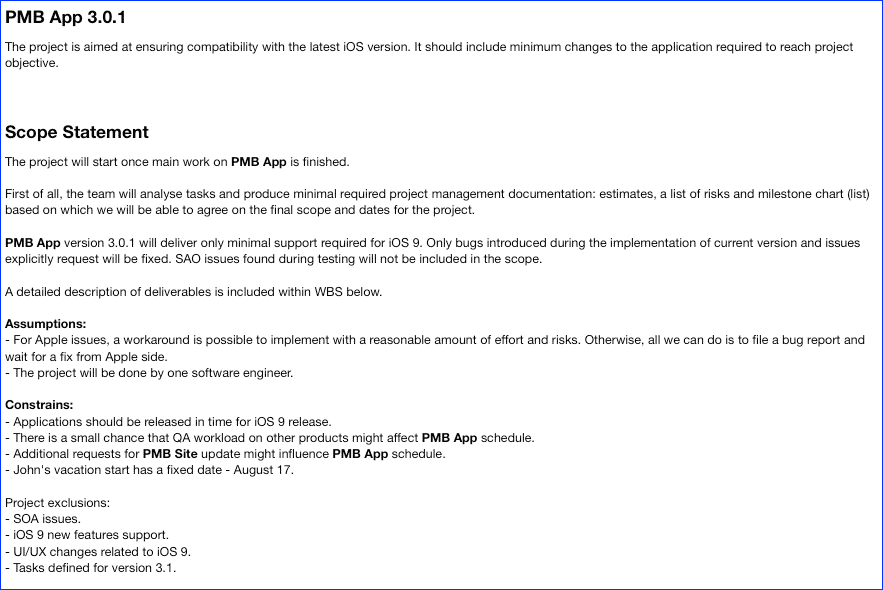When creating a project, you must also produce a document that details exactly what it comprises. This document, which examines the project scope, is an essential component of your process because it helps everyone on the team to see what needs to be done and what has been promised. But first, let’s go through what the project scope is and how you can construct a document that will keep you and your team on track. We’ll also see a project scope statement example that will serve as a guide while we are writing one.
What is the Project Scope?
The project scope is a detailed description of the project effort required to meet the expectations of the stakeholders. It discusses what is included. However, addressing what is excluded can considerably increase the clarity of the required job. There are two kinds of scope: 1) Product Scope and 2) Project Scope
Product Scope
Product scope is a subset of the project scope. It defines the effort required to achieve the project’s deliverables requirements. Project Scope Management is important because products are the project’s main deliverables. Special project papers and methods are utilized to verify that the final result meets the acceptance criteria of the project stakeholders. The Requirements Management Plan and the Requirements Traceability Matrix are two unique project papers dedicated only to Product Scope.
Configuration Management is a distinct procedure created to handle changes in the functional or physical properties of the Product. Before they can be acknowledged and distributed to the right stakeholders, the goods must also go through verification and validation processes.
Project Scope
The Project Scope contains the Product Scope and also defines all of the other work that must be performed by the project. It is specified in the Scope Management Plan as well as the Scope Baseline, and it is documented in the Project Management Plan. Scope Management Plan outlines how the scope will be planned, performed, and controlled. The Scope Baseline describes the Project Scope in three documents:
- The Scope Statement
- Work Breakdown Structure (WBS)
- WBS Dictionary.
The Scope Baseline is the document against which they measure the scope performance.
What is a Project Scope Statement?
A scope statement, which is often done by the project manager, covers the whole project, including any deliverables and their characteristics, as well as a list of stakeholders who will be impacted. It will also include any main project objectives, deliverables, and goals to help quantify performance.
Your project scope statement will be the key tool for stakeholders and teams to refer to and use as a guideline to appropriately gauge project success.
Today, I’d like to demonstrate how to control scope more dependably, using a real-world example.
Example of a Real-Life Project Scope Statement
Below is the project scope statement for a modest real-world project as an example.
(I have changed the names of the items and clients.)
The ideas of project scope management will be the same for any project. Even a large one will have all of the same components.

So, don’t overcomplicate scope management.
It’s also worth noting that it’s overly basic. Also, you do not have to include everything that the PMBOK Guide recommends. Just make sure the Scope Baseline serves its job.
Outline of the Project Scope Statement
Similar to the Five W’s of Journalism—Who, What, When, Where, and Why—to have your project scope statement properly written, you must address the following seven points:
#1. Justification
No project begins without an existing need, so utilize that as your argument. Begin your project scope statement by stating the need for your project and how the ultimate result will meet that requirement.
Examples of needs include:
- A competitor has launched a new product that currently has no market competition.
- Customer feedback has shown a desire for a new tool to be part of your product.
- A possibility for vertical integration/recurring revenue has emerged.
#2. Scope of Work
This may appear to be a simple step, yet it is one of the most crucial in the project scope statement. List what is and is not within the scope of your project at a high level. This will aid in establishing the project’s boundaries. It also handles your stakeholders’ expectations/input and provides your team members with some creative constraints to operate within.
Project management software can help you better manage your stakeholders.
#3. Business goals
Outline your business objectives by stating the goals you aim to achieve with this project. This can involve product launch dates, a new business strategy to provide a greater percentage of recurring revenue, higher customer happiness, increased first-time customers, and other things.
#4. Project Deliverables
Make a list of the deliverables that your team members must create to satisfy company objectives. This can comprise the product itself, instruction and installation manuals, marketing materials, news releases, advertising campaigns, as well as other resources.
#5. Project Exclusions
While it is critical to specify the project’s boundaries from the start, it is also critical to list what the project does not include. For instance:
- Application upgrades that are planned for a subsequent project but are not included in this project.
- Customer access to specific support lines/product functionalities that have been restricted or rescheduled.
#6. Constraints
Project constraints are what make project management such a difficult problem to handle. The top three limitations in project management are usually time, money, and scope. They interrelate, which means that if you pull one lever on ‘scope,’ another lever on ‘money,’ or ‘time,’ will also move.
However, more project restrictions can arise at any time, such as risk, resources, organization, approach, customers, and so on. List all of the restrictions you anticipate in your project so that you may strive to have solutions ready to go when they arise.
#7. Assumptions
Your project assumptions usually revolve around the very elements that wind up being constraints, such as time, money, and scope. For example, in this part, you might write, “the front-end development team will be available during this project period,” or “the customer service team will receive new product training by x time.” It is critical to mention these since this will not only inform key stakeholders about your core resource requirements to complete the project, but it will also provide you with immediate insight into where your biggest risk factors are.
Your project scope statement outline will serve as a guideline as you create your comprehensive scope statement. Because, while predicting the project’s future is impossible at this level, this is the first step toward bringing your project as close to the outcome as feasible. You can get a head start on a successful project by beginning with the seven critical assertions listed above.
Read Also: Closing Statement: Definition and Tips for Writing Effective Statement
What Sets a Project Scope Statement Apart from Other Project Management Documents?
While a project scope statement is essential for project success, certain aspects of the project are covered in separate documents. Here are two prominent instances.
Product scope statement Just as there are small differences between the jobs of a product manager and a project manager, there are some variances between project scope and product scope. A product scope contains more information on the characteristics and functions of the product, service, or solution that a project will produce. The project scope may declare, “Ship a new tablet PC by the end of 2020,” but the product scope will include information such as screen size, processor type, amount of RAM, and so on.
Master plan for the project. If the project scope statement is the foundation upon which they build the project, then the project master plan is the rest of the structure. According to Alexis, the project master plan includes a thorough project timeline and work organization, as well as policies and procedures for risk management, quality management, and communications management. The strength of your project scope statement, on the other hand, determines the success of your project master plan, he says.
How to Sharpen Your Project Management Skills
Earning a master’s degree in project management is one option to gain project management knowledge and abilities in a professional context. Along with learning how to create a project scope statement, you will also learn how to engage with executives and project sponsors, practice using soft skills to manage teams, and prepare to take on increased responsibility by managing a larger team and/or a larger budget.
Project Scope Statement FAQs
What should not be included in your project scope statement?
Project exclusions, assumptions, and limitations (among other information) are present in a Project Scope Statement.
What are the six elements of a typical scope statement?
Typical components of a project scope statement include a project aim, justification, product description, projected outcomes, assumptions, and constraints.






